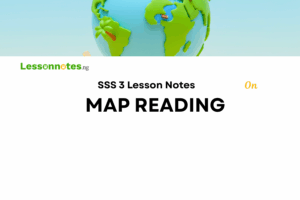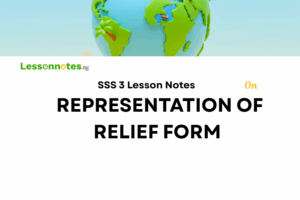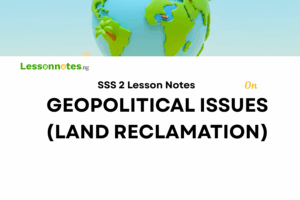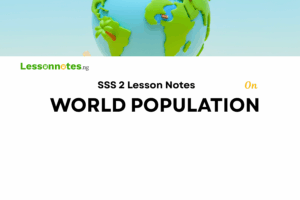Settlement SS2 Geography Lesson Note
Download Lesson NoteTopic: Settlement
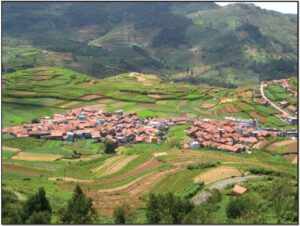
A settlement is defined as a place containing one or more buildings with people living in them. A settlement can be a city, village or compound.
Favourable conditions for siting a settlement:
- Adequate water supply
- Fertile soil
- Availability of low and well-drained land.
- Good communication network
- Defense/Protection for human habitation.
FACTORS AFFECTING GROWTH OF SETTLEMENT
Some of the factors that promote the growth of towns, cities or states and finally lead to urbanization are:
- Accessibility by road, rails, air etc.
- Presence of economic activities such as trading, farming, mining etc.
- Good administration /seat of government.
- Provision of social amenities like pipe-borne water, electricity etc.
- Good soil condition that encourages intensive agriculture.
- Absence of disaster.
- Political stability.
- Relief and drainage.
- Favourable climatic conditions.
CLASSIFICATION OF SETTLEMENT ACCORDING TO TYPES
There are two main types of settlements:
- Rural settlements
- Urban settlements
- Rural Settlements:
i. A rural settlement is relatively a small area with socially homogeneous people who know themselves very well.
ii. A rural settlement could be nucleated, dispersed or linear.
iii. They consist of people with the same cultural background and language.
iv. They are normally involved in primary activities such as farming, fishing, hunting and lumbering.
v. They live a simple lifestyle with few social amenities.
vi. They are normally made up of a few buildings with people ranging from one family to a few hundred.
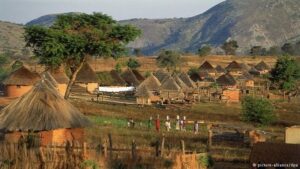
Types Of Rural Settlements
There are three (3) types of rural settlement. These are:
i. Homestead: This is a family residence. They have dispersed settlements which are separated by bushes, called buffer zones.
ii. Hamlet: This settlement may be nucleated with few houses, usually less than a hundred with many people living in them.
iii. Village: This is a large nucleated rural settlement formed from the combination of several hamlets. It contains several hundreds or a thousand people with limited services.
Functions Of Rural (Village) Settlement
A village performs the following functions:
i. Agricultural function
ii. Lumbering function
iii. Small-scale shopping e.g. Petty shops and local markets
iv. Fishing function
v. Religions function
- Urban Settlements
i. An urban settlement is a relatively large, densely populated settlement with socially heterogeneous people who do not know one another very well.
ii. Urban settlements are nucleated in nature.
iii. They consist of people with different cultural backgrounds and different languages.
iv. They consist of many buildings with thousands of people living in them.
v. They have abundant social amenities.
vi. They are mainly involved in secondary activities such as manufacturing, construction, banking etc.

Types Of Urban Settlements
Four (4) major types of urban settlements exist. These are:
- Town: With several thousands of people.
- City: This is a large town with a greater number of people than a town.
- Conurbation: This is made up of several towns joined together but each town still maintains its identity
- Megalopolis: It is the largest type of urban settlement made up of large cities with several millions of people. Megalopolis simply means, megacities joining together to form one big city.
Functions of Urban Settlement
Most urban settlements perform the following functions:
i. Industrial functions e.g. manufacturing industries.
ii. Commercial functions e.g. presence of markets, banks, shopping malls etc.
iii. Administrative functions e.g. seats of government, states and federal capitals etc.
iv. Socio-Cultural functions e.g. establishment of universities, churches, mosques, cinemas etc.
v. Mining function.
vi. Residential functions.
CLASSIFICATION OF SETTLEMENT ACCORDING TO PATTERN OR SHAPE
The pattern or shape of a settlement refers to the arrangement of buildings in a settlement.
There are three main patterns of settlement. These are:
- Dispersed
- Nucleated
- Linear settlement
- Dispersed Or Scattered Settlement
Characteristics
a) Dispersed settlements have buildings scattered or far from each other.
b) They have few social amenities because they are rural.
c) They are mainly involved in primary activities like farming, lumbering etc.
d) Individual buildings are widely spaced from one another and; behind the buildings, these are family parcels of land.
e) They live a quiet lifestyle.
f) The dispersed pattern of settlement reduces conflict among families because individual families are distinctly far apart.
2. Linear Settlement
Characteristics
a) The buildings are located along the routes e.g. roads, railways or rivers.
b) Where two or more routes meet, a sub-linear settlement called a nodal town is formed.
c) When a settlement is formed as a result of the meeting of two rivers; a confluence town or settlement is formed e.g. Lokoja, in Nigeria, Khartoum (Sudan) where the Blue Nile and the White Nile meet.
d) Gardens are located behind houses.
e) Farmlands may be located behind gardens.
f) Linear settlements could extend to several kilometres in length.
g) Some of the reasons for linear settlement are:
– The need to be close to a transport network.
– or easy accessibility to other areas.
– The need to transport farm produce to markets.
3. Nucleated Or Dense Settlement
Characteristics
a) Here, the buildings are very close to each other or they are concentrated in a small area.
b) It has many social amenities.
c) It is a feature of urban settlement.
d) People are mainly involved in secondary and tertiary activities like manufacturing, construction etc.
e) The area is well connected with roads.
f) Farmlands are located outside the settlement.
g) The level of interaction between the inhabitants is very high.
Reasons Or Need For Nucleated Settlement
i. The quest to maintain social ties.
ii. It leads to easy development of infrastructure and social amenities.
iii. The need for defence.
iv. There is easy communication.
v. For commercial development.
vi. It enhances a well-defined leadership structure.
ASSIGNMENT
- One of these is not a factor for citing a settlement.
(a) Good soil condition (b) Good communication network (c) To preserve slavery
- The smallest type of settlement is called ______
(a) Village (b) Hamlet (c) Homestead
- When several towns join together but each town still retains its identity it is called ______
(a) conurbation (b) nuclear town (c) Megalopolis
- The type of settlement located along major transportation routes is called ______ settlement.
(a) dispersed (b) Linear (c) Nucleated
- Which of these is not a major function of a rural settlement?
(a) Agricultural function (b) Industrial function (c) Religious function


